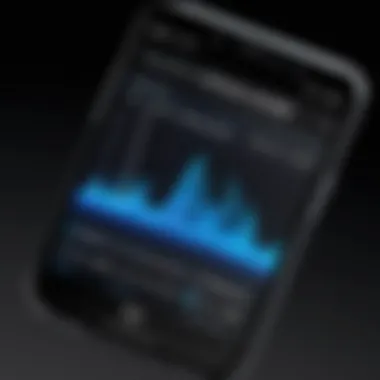Mastering the Art of Scoring Cell Phone Deals


Intro
The importance of understanding the landscape of cell phone purchasing cannot be overstated. Many individuals aim to balance quality with cost, yet they often find themselves lost in a multitude of choices. Therefore, grasping the nuances, such as when to shop and which features matter most, is essential in making financially sound decisions. Throughout this article, various aspects, including seasonal sales, trade-in programs, and financing options, will be examined to provide a holistic view. By the end, readers will have the necessary tools to navigate the complexities of cell phone purchases effectively.
Understanding the Market for Cell Phones
Understanding the market for cell phones is crucial for anyone looking to buy a new device. It offers insights into current pricing trends, manufacturers' pricing strategies, and how technological advancements impact the overall cost. By grasping these elements, consumers become more equipped to identify good deals and make informed decisions.
A saturated market often leads to confusion for buyers. Different models, features, and price ranges can make it challenging to find the right device without overspending. Comprehending the market dynamics allows buyers to navigate these complexities with ease and to pinpoint value where it is not immediately obvious. Those who are well-informed are better positioned to negotiate prices and take advantage of promotions.
Understanding how to analyze market trends can save money and time. It allows consumers to weigh their options effectively and make choices aligned with their specific needs. This section will delve into significant subtopics.
Current Trends in Cell Phone Pricing
Cell phone pricing is currently influenced by several factors, including brand position, demand, and global economic conditions. In recent years, there has been a noticeable trend toward higher starting prices for flagship models from brands like Apple and Samsung. These devices feature cutting-edge technology and extensive marketing, hence the premium price tags. However, this has opened avenues for competitive mid-range devices, such as those from brands like Google and Xiaomi, which offer commendable features at lower prices.
Many consumers are also watching for sales events, such as back-to-school discounts or seasonal promotions, which can yield substantial savings. Learning when these discounts occur is vital for budget-conscious buyers. Thus, being aware of how prices fluctuate can lead to advantageous purchasing decisions.
How Manufacturers Influence Pricing Strategies
Manufacturers play a pivotal role in determining the retail prices of cell phones. They must assemble various components, from screens to processors, that directly affect production costs. High-profile companies often adopt premium pricing strategies, securing their place in the market as leaders. However, the pressure from emerging brands and cost-efficient alternatives forces them to introduce budget-friendly options as well.
Additionally, manufacturers sometimes offer trade-in programs and rebates, improving consumer perception of purchase value. Some carriers also collaborate with manufacturers to subsidize the costs of new devices. Therefore, understanding these pricing strategies can give buyers leverage when negotiating with retailers or deciding whether to upgrade their existing devices.
Technology Advancements and Their Impact on Prices
Technological advancements consistently reshape the landscape of cell phone pricing. With each new release, devices often incorporate features such as enhanced cameras, better batteries, and advanced processing power. As a result, older models tend to decrease in value faster when new iterations enter the market.
This rapid progression often creates windows of opportunity for consumers. Those who are savvy can capitalize on significant drops in price on slightly older models, which still meet high performance standards. Recognizing how technology impacts pricing enables informed decisions, possibly reducing overall expenditure on cell phone purchases.
"A good understanding of market trends allows consumers to identify not only the best time to buy but also the option that best fits their lifestyle and budget."
By evaluating the factors that affect cell phone pricing and how they evolve, we position ourselves to secure better deals in the competitive marketplace.
Evaluating Your Needs Before Purchase
Before diving into the myriad of cell phone options available today, it is essential to take a step back and evaluate your personal needs. This not only simplifies the selection process but also ensures that the investment you make aligns with your specific usage requirements. Understanding your requirements is foundational in making a purchase that provides satisfactory value and functionality.
Knowing exactly what you need can prevent buyer's remorse, where you find yourself unhappy with your device too soon after acquiring it. Therefore, taking time to consider important factors will ultimately enhance your overall experience after the purchase.
Prioritizing Specifications versus Brand
When selecting a cell phone, the balance between specifications and brand reputation is crucial. Manufacturers like Apple, Samsung, and Google each have a distinct following, often influencing purchasing decisions significantly. However, it is vital to dig deeper into what specifications matter to you rather than simply following the brand name.
For instance, if photography is important, then looking closely at the camera capabilities is necessary. Does it have a good megapixel count? What about features like night mode and optical zoom? You might find that a lesser-known brand offers superior camera specs at a lower price point compared to a bigger brand.
Here are some points to consider when prioritizing specifications:
- Performance: Evaluate processor speed and RAM, especially for multitasking needs.
- Camera Quality: Pay attention to lens quality, additional features, and software processing.
- Battery Life: Look for devices that offer extended battery life if you are a frequent user.
- Display Size and Quality: A clear display with the right size is essential for media consumption.


While brand loyalty is understandable, a clear understanding of specifications can lead to smarter purchases that better fit personal criteria.
Understanding your Usage Patterns
The next step in the evaluation process is to analyze your usage patterns. Take a moment to assess how you typically interact with your phone. Do you primarily use it for basic tasks like calling and texting? Or do you engage in extensive browsing, gaming, or content creation? Patterns of usage significantly impact the type of phone that will best serve your needs.
Understanding these habits can help you focus on essential features. For example:
- If you watch a lot of videos, your priority may be a high-resolution display and powerful speakers.
- If you often travel, features like extended battery life and durability become significant.
- If gaming is your main activity, seeking a device with a robust graphics processor would be wise.
"Identifying usage patterns helps tailor the smartphone to fit your lifestyle, ensuring optimal satisfaction."
Exploring Retail Options for Best Deals
Finding the right deal on a cell phone requires careful consideration of where to purchase. The retail environment for cell phones has transformed significantly over the years. Today, consumers have a variety of options ranging from e-commerce sites to physical stores. Understanding these retail options is crucial for securing the best deal possible. Each avenue presents its own advantages and disadvantages, impacting pricing, availability, and after-sales support.
Comparative Analysis of Online vs. Brick-and-Mortar Stores
The first step in exploring retail options is comparing online platforms to traditional brick-and-mortar stores. Online shopping offers convenience and often better price comparisons. Websites like Amazon and Best Buy allow consumers to quickly evaluate different models and prices in one place.
However, while shopping online, one must consider shipping times and the inability to physically handle the device before purchase. On the other hand, brick-and-mortar locations, such as local retailers or carrier stores, provide immediate access to products. Prospective buyers can interact with sales staff, ask questions, and get a feel for the device. This tactile experience can be quite valuable, especially for high-end smartphones.
A balance can often be struck by starting online to review options and then visiting a store to see devices in person.
Reputable Online Retailers to Consider
When shopping online, it is essential to choose trustworthy retailers. Reputable online sources include:
- Amazon: Known for its wide selection and frequently updated prices.
- Best Buy: Offers a good combination of online ordering and in-store pickup options.
- Newegg: Particularly strong for electronics, often providing competitive pricing and deals.
- B&H Photo Video: This retailer is known for excellent customer service and a solid reputation in tech sales.
- Walmart: Offers both online and in-store shopping, often with competitive pricing and promotional deals.
Using these retailers can help ensure a safe shopping experience.
Purchasing From Manufacturer Direct versus Resellers
Another critical consideration is whether to purchase directly from manufacturers such as Apple, Samsung, or Google or to go through resellers. Buying from the manufacturer often guarantees an authentic product and may provide better warranty support. Manufacturers frequently run exclusive promotions that are not available through other channels.
Conversely, resellers sometimes offer lower prices and additional incentives like bundled accessories or service plans. It is essential to weigh the benefits of purchasing direct against the potential savings from resellers.
"Shopping smart means understanding where to buy and ensuring you get the best possible deal."
Timing Your Purchase
Choosing the right moment to buy a cell phone can significantly impact the deal you secure. The cell phone market experiences fluctuations in pricing, often dictated by seasonal sales, new model releases, and major promotional events. Understanding when to make your purchase can position you to take advantage of lower prices and special offers.
Timing involves analyzing market trends and aligning your purchase with your needs and preferences. Consider the ideal moment when your current device is failing, allowing you the freedom of not being rushed into a hasty decision. Moreover, being informed about common sales events can further enhance your ability to snag a good deal.
Seasonal Discounts: When to Buy
Different seasons present unique opportunities for discounts in the smartphone market. Specifically, spring and fall are key times when companies often release new models. During this period, previous models may see significant price drops to clear inventory.
For instance:


- Spring Sales: After unveiling new models, brands typically reduce prices on last year’s devices, making it an opportune time for purchases.
- End of Year Discounts: Retailers often clear stock ahead of the holidays, leading to aggressive promotions.
"Understanding seasonal trends helps consumers plan purchases more effectively, ensuring they do not pay more than necessary."
Keeping track of these cycles can help you make a more informed buying decision. Consider waiting until the end of a current season for the best price on last year's models.
Promotional Events: Black Friday, Cyber Monday, Back to School
Promotional events such as Black Friday, Cyber Monday, and back-to-school seasons are critical for finding good deals on cell phones. These events typically feature major discounts across multiple retailers.
- Black Friday usually brings significant markdowns on various electronics, including cell phones. Retailers like Best Buy and Amazon often provide doorbuster deals that are hard to miss.
- Cyber Monday shifts the focus online, offering exclusive deals that may not surface during in-store shopping.
- Back to School promotions are aimed at students, leading to discounts that can benefit everyone, especially when buying for younger users or family members.
By leveraging these events, you can often access phones that may be otherwise out of budget. Track upcoming sales and create reminders to prepare in advance. This strategy allows shoppers to navigate the crowded market more efficiently, ensuring they capitalize on discounted prices.
Identifying Promotions and Coupons
Identifying promotions and coupons is a critical component when seeking good deals on cell phones. The market is flooded with various options, and manufacturers often provide incentives to help move inventory. This section will delve into how consumers can strategically utilize promotions and coupons, leading to substantial savings.
Promotions can take various forms, including temporary price reductions, bundled deals, and loyalty rewards. Coupons, on the other hand, typically offer direct discounts that can be applied during the purchasing process. Both methods warrant careful consideration for astute consumers aiming to optimize their purchase.
Utilizing these discounts allows buyers to minimize costs while maximizing their purchasing power. In the highly competitive landscape of cell phone sales, effectively pinpointing available promotions can make a significant difference in the overall amount spent.
Manufacturer Rebates and Trade-In Deals
Manufacturer rebates and trade-in deals are two popular forms of promotions offered by cell phone brands. Rebates often involve purchasing a device and submitting proof of purchase to receive money back after a designated period. This is a straightforward way to reduce the net price paid for the device. However, it is essential to read the terms carefully; rebates might be contingent upon specific conditions, such as product registration or online submissions. The time frame for receiving the rebate can also vary, which impacts cash flow.
Trade-in deals allow customers to exchange their old phone for credit against a new purchase. This approach encourages upgrades and helps consumers save money while disposing of outdated technology responsibly. Trade-in values differ by brand, model, and condition of the device. Therefore, researching the potential trade-in value before making a new purchase can help consumers assess whether this option is advantageous.
Third-Party Coupon Integration
Third-party coupon integration can further enhance purchasing strategies. A variety of websites and apps offer coupons specifically for electronics, including cell phones. This method provides easy access to potential discounts that might not be available through manufacturers or retailers alone.
Engaging with platforms such as RetailMeNot or Honey can lead to finding valuable codes or deals tailored for specific models or brands. Inline with other promotions, buyers should verify the authenticity of these coupons. Some may have exclusions or are limited to certain retailers, so it is crucial to check the details before attempting to redeem them.
Assessing Financing and Payment Plans
Assessing financing and payment plans is crucial when searching for good deals on cell phones. Different payment options can significantly impact your overall expenditure and cash flow. Understanding how these plans work helps in making more informed choices, saving you from unexpected financial burdens. The condition of the technology market compels consumers to be well-informed about the various payment structures available, especially given the high costs of many modern smartphones.
A well-structured financing plan should cater to your financial situation, allowing you to manage your budget while acquiring the latest technology. By evaluating different options, you can avoid falling into unfavorable terms that lead to more debt.
In-House Financing Options from Carriers
In-house financing from carriers allows consumers to pay for the cell phone through their mobile service provider. Companies like AT&T and Verizon often provide these financing plans, making it simple to integrate the phone into your monthly bill. This method offers several benefits, such as:
- Convenience: No need for a third-party lender; payments are straightforward on your monthly bill.
- Flexible Terms: Carriers may offer various terms, making it easier to find a plan that fits your budget.
- Promotional Offers: Some carriers may lower the cost of the phone or provide other incentives if you choose their financing option.
However, it is essential to read the fine print. Missed payments could lead to penalties or affect your credit score negatively. Understanding the contract's terms before committing is vital.
Installment Plans versus One-Time Payments
When purchasing a cell phone, you typically face two primary payment methods: installment plans and one-time payments. Each option has its pros and cons that you should carefully consider.


Installment Plans:
- Lower Immediate Cost: Significant upfront costs are spread over several months.
- Manageable Payments: Monthly installments can ease the financial load, especially when you are aiming to buy high-end devices.
One-Time Payments:
- Full Ownership: Paying all at once means you own the device outright from day one.
- No Future Payments: This option avoids interest and finance charges that might be part of an installment plan.
Ultimately, the choice between installment plans and one-time payments depends on your financial situation and preferences. Analyze your current budget, the importance of immediate ownership, and potential future costs.
It is essential to align your payment choice with both your needs and your financial health to ensure a satisfactory purchase experience.
Understanding Warranty and Protection Plans
In the realm of cell phone purchases, understanding warranty and protection plans is crucial. These elements serve as safety nets for consumers, ensuring that their investment is safeguarded against unforeseen circumstances. A warranty typically covers defects in materials and workmanship, which is vital when considering the longevity and reliability of a device. On the other hand, protection plans often encompass accidental damages, which can occur at any time, leaving consumers vulnerable.
When evaluating the options available, it is essential to consider various specific elements regarding both warranties and protection plans. Firstly, the length of coverage is significant. Many manufacturers provide a one-year warranty, but extended warranties can offer additional security, sometimes for a few extra years. However, it is imperative to read the fine print. Some extended warranties may only cover certain types of damages, or they might require a deductible for repairs.
Moreover, it is crucial to assess whether the plan allows for repairs through authorized service centers or if third-party locations are acceptable. The convenience of accessing service can influence your decision. Additionally, consider whether the protection plan is transferable to a new owner, which can add value should you decide to sell or trade-in your phone in the future.
"An informed user makes better choices when it comes to warranties and protective plans. Never assume all plans are the same."
In summary, understanding warranty and protection plans helps in making a prudent investment, as they directly affect the total cost of ownership of a cell phone. The goal is to be adequately informed and prepared for any complexities that may arise post-purchase.
Evaluating Extended Warranty Options
When considering extended warranty options, it is helpful to weigh both the benefits and the potential downsides. Extended warranties can provide peace of mind, particularly for high-value devices or in scenarios with a risk of accidental damage. Some plans may cover specific aspects such as battery replacement or screen repairs, which are common points of failure in smartphones.
Additionally, be aware of the warranty’s geographical coverage. If you travel frequently, ensure that the warranty is valid internationally. Often, costs associated with international repairs can be significantly higher, making a good extended warranty even more valuable. Furthermore, evaluate the customer service track record of the warranty provider. Negative reviews regarding support can lead to frustrating experiences, particularly when urgent repairs are needed.
Ultimately, choosing the right extended warranty depends on personal preferences, risk tolerance, and device usage patterns.
Importance of Device Protection Coverage
Device protection coverage serves to offer peace of mind and financial safety against unexpected accidents or damages. Many consumers overlook this aspect, assuming that standard warranties will suffice. However, the reality is that accidents happen, and malevolent factors such as drops, spills, or theft can occur at any moment.
It becomes essential to differentiate between standard warranty coverage and comprehensive device protection. While a warranty may cover manufacturing defects, device protection typically includes a broader range of issues. This can prove invaluable, especially if the consumer is prone to being hard on their phones or if the device is used in high-risk environments.
To summarize, when purchasing a cell phone, evaluating both warranty and protection plans is a key strategy for securing a good deal. It goes beyond immediate cost considerations, leading to more sustainable financial choices regarding your device. Ultimately, consumers should always weigh the associated risks and the potential benefits of these plans.
Final Considerations Before Making a Purchase
Before committing to a cell phone purchase, there are significant elements to review. Final considerations will safeguard your investment. The cell phone market is intricate, with many options. Understanding the details can impact your overall satisfaction with the device.
Returning Policies and Customer Support
A crucial element to consider is the returning policy of the retailer. If the phone does not meet your expectations, knowing the return window is essential. Many retailers offer varying return periods, each with specific conditions. Read the fine print. Some may charge restocking fees, and others might have conditions on the device condition.
Good customer support can alleviate many concerns post-purchase. If difficulties arise with the device, responsive support can save you time and stress. Investigate what support options are available. Is it easy to reach their support team? Are there online resources like an FAQ or live chat? Consider brands such as Apple or Samsung, known for their robust customer service.
Community Reviews and User Feedback Importance
User feedback is invaluable when deciding on a new cell phone. Community reviews offer insight beyond technical specifications. Reading reviews from actual users helps you understand practical aspects of the device, such as battery life, usability, and software updates.
Online platforms like Reddit and tech forums can provide genuine insights. High user ratings can indicate quality and reliability. Pay attention to both high and low ratings. High ratings might reveal satisfied customers, while low ratings often detail specific concerns that some users face. This can highlight whether it’s a common issue.
"A product may have fantastic specifications, but if user reviews indicate a recurring problem, it’s wise to reconsider."







